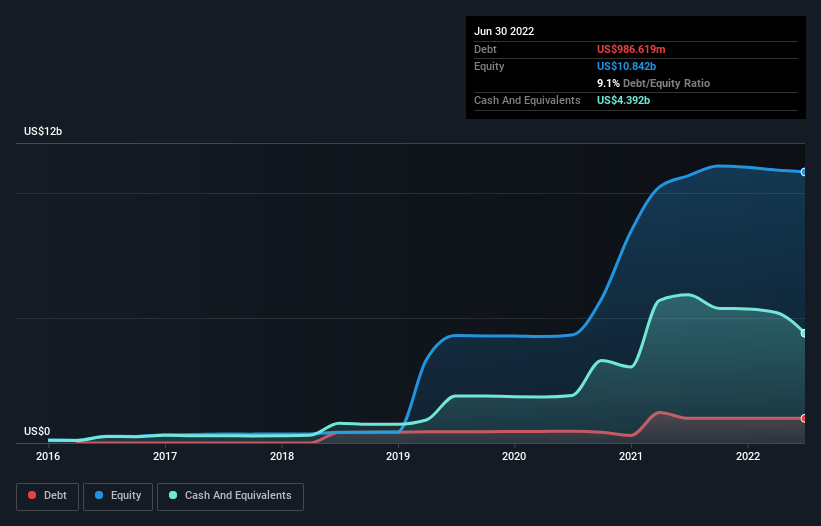
Some say volatility, rather than debt, is the best way to think about risk as an investor, but Warren Buffett famously said that 'Volatility is far from synonymous with risk.' When we think about how risky a company is, we always like to look at its use of debt, since debt overload can lead to ruin. We note that Twilio Inc. (NYSE:TWLO) does have debt on its balance sheet. But should shareholders be worried about its use of debt?
When Is Debt Dangerous?
Debt is a tool to help businesses grow, but if a business is incapable of paying off its lenders, then it exists at their mercy. Ultimately, if the company can't fulfill its legal obligations to repay debt, shareholders could walk away with nothing. However, a more usual (but still expensive) situation is where a company must dilute shareholders at a cheap share price simply to get debt under control. Of course, debt can be an important tool in businesses, particularly capital heavy businesses. The first step when considering a company's debt levels is to consider its cash and debt together.
Check out the opportunities and risks within the US IT industry.
How Much Debt Does Twilio Carry?
The chart below, which you can click on for greater detail, shows that Twilio had US$986.6m in debt in June 2022; about the same as the year before. However, it does have US$4.39b in cash offsetting this, leading to net cash of US$3.41b.

A Look At Twilio's Liabilities
Zooming in on the latest balance sheet data, we can see that Twilio had liabilities of US$795.3m due within 12 months and liabilities of US$1.23b due beyond that. Offsetting these obligations, it had cash of US$4.39b as well as receivables valued at US$471.9m due within 12 months. So it can boast US$2.84b more liquid assets than total liabilities.
This surplus suggests that Twilio is using debt in a way that is appears to be both safe and conservative. Due to its strong net asset position, it is not likely to face issues with its lenders. Succinctly put, Twilio boasts net cash, so it's fair to say it does not have a heavy debt load! The balance sheet is clearly the area to focus on when you are analysing debt. But ultimately the future profitability of the business will decide if Twilio can strengthen its balance sheet over time. So if you want to see what the professionals think, you might find this free report on analyst profit forecasts to be interesting.
Over 12 months, Twilio reported revenue of US$3.4b, which is a gain of 51%, although it did not report any earnings before interest and tax. Shareholders probably have their fingers crossed that it can grow its way to profits.
So How Risky Is Twilio?
We have no doubt that loss making companies are, in general, riskier than profitable ones. And in the last year Twilio had an earnings before interest and tax (EBIT) loss, truth be told. Indeed, in that time it burnt through US$254m of cash and made a loss of US$1.1b. While this does make the company a bit risky, it's important to remember it has net cash of US$3.41b. That means it could keep spending at its current rate for more than two years. Twilio's revenue growth shone bright over the last year, so it may well be in a position to turn a profit in due course. Pre-profit companies are often risky, but they can also offer great rewards. There's no doubt that we learn most about debt from the balance sheet. However, not all investment risk resides within the balance sheet - far from it. For example, we've discovered 4 warning signs for Twilio (1 makes us a bit uncomfortable!) that you should be aware of before investing here.
If you're interested in investing in businesses that can grow profits without the burden of debt, then check out this free list of growing businesses that have net cash on the balance sheet.
Valuation is complex, but we're here to simplify it.
Discover if Twilio might be undervalued or overvalued with our detailed analysis, featuring fair value estimates, potential risks, dividends, insider trades, and its financial condition.
Access Free AnalysisHave feedback on this article? Concerned about the content? Get in touch with us directly. Alternatively, email editorial-team (at) simplywallst.com.
This article by Simply Wall St is general in nature. We provide commentary based on historical data and analyst forecasts only using an unbiased methodology and our articles are not intended to be financial advice. It does not constitute a recommendation to buy or sell any stock, and does not take account of your objectives, or your financial situation. We aim to bring you long-term focused analysis driven by fundamental data. Note that our analysis may not factor in the latest price-sensitive company announcements or qualitative material. Simply Wall St has no position in any stocks mentioned.
About NYSE:TWLO
Twilio
Provides customer engagement platform solutions in the United States and internationally.
Excellent balance sheet and fair value.


